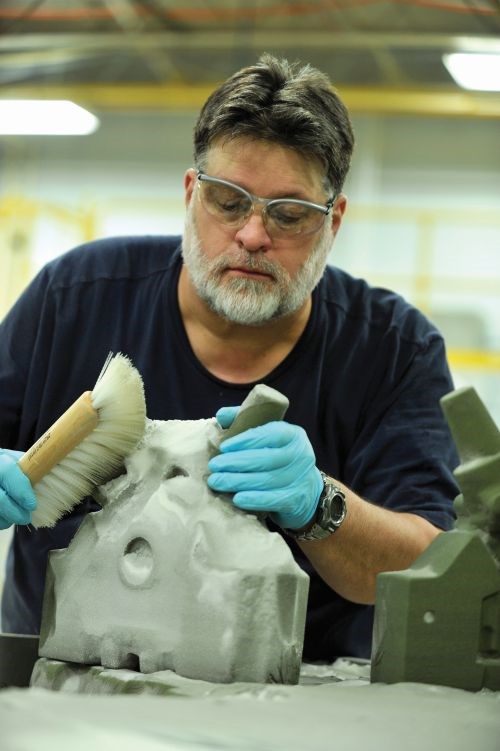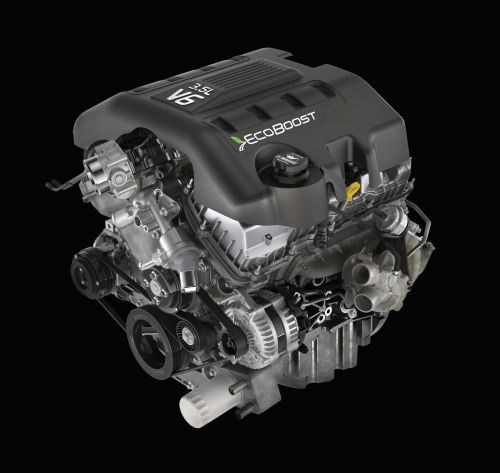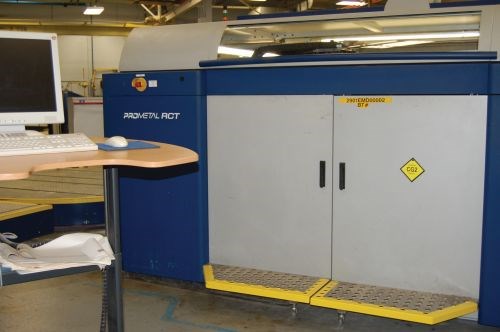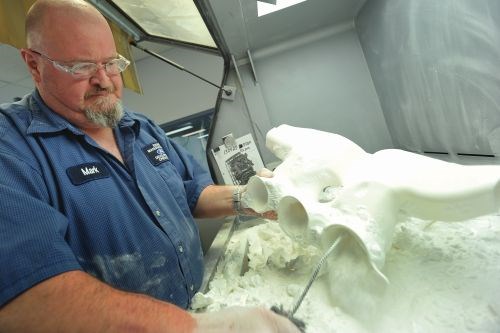The New Pattern for Prototyping
Ford is building engineering confidence through nearly production-ready prototype parts, which provide reliable test data—all thanks to additive manufacturing.
Share


ECi Software Solutions, Inc.
Featured Content
View More



Autodesk, Inc.
Featured Content
View More

.png;maxWidth=45)
DMG MORI - Cincinnati
Featured Content
View MoreTo gauge how widely the Ford Motor Company uses 3D printing, just count the number of castings in one of its vehicle’s engine and transmission. On newer vehicles, practically every one of those castings was prototyped using 3D sand printing.
That is, 3D printing in sand is used to quickly generate molds and cores for prototype parts, without any need to make a pattern first. Because of the increased number of design iterations that this type of prototyping permits, relying on 3D printing in this way can result in a better vehicle.
Paul ExOne’sSusalla, Ford’s section supervisor of rapid manufacturing, is involved in much of this prototyping. He works at a Dearborn, Michigan facility where 3D sand printing is performed using ExOne’s S-15 digital mold and core-making system. He emphasizes that, though we are speaking of prototypes, Ford’s prototype volumes could surpass what many manufacturers consider to be full production.
“We use [the ExOne S-15 system] for almost all of our prototype castings in powertrain, suspension and other components—cylinder heads, cylinder blocks, crank shafts, front covers, oil pans,” Susalla says. “Basically, any castings you see in an engine or transmission, we are prototyping here using 3D sand printing.”
Those parts will go directly on engines and transmissions that are run either on a dynamometer or in test vehicles to obtain data to help engineers understand the design and determine any necessary modifications.
“And these are durability vehicles,” says Harold Sears, Ford additive manufacturing technical specialist. “They may run 1,000 hours in a dyno—equivalent to 100,000 miles in a test vehicle.”
He says the prototypes for parts on Ford’s EcoBoost engines were made this way, including “all of the original cylinder heads for the 2-liter EcoBoost that you can get on so many vehicles today.” In fact, “the first 100 engines and their cylinder heads were cast using this technology.”
Before and After
A cylinder head is a difficult part to make, requiring 12 to 20 cores and mold components to be sand-cast. Before using 3D sand printing for metal castings, the process for making a cylinder head involved making patterns, usually by machining them from tooling board, and packing foundry sand in the mold.
Creating all of the tooling would take months and a lot of money. Plus, “Some of these cores are extremely tough to make,” Susalla says.
“Now when using 3D printing, it’s just a matter of getting a file and putting it through the machine and coming out with the same cores,” he says. “There is no tooling, no time involved.”
3D Sand Printing Benefits
The most important benefit of 3D sand printing is the speed of the process. “In a nutshell, if you look at the traditional way of making a casting, you are months out before you get your first casting, and with 3D sand printing you can have a casting in a matter of days to a couple of weeks,” Susalla says.
He explains that, if you are using tooling, it might be four months down the road before you get your first part and realize that it’s not what you want. Then the tooling must be changed. “If you look at the product development cycle, Ford, GM and Chrysler only give you x number of months to years to put it on paper and then get it on the street,” he says. “As an engineer, you only have a certain amount of time to get your part right. The traditional method might give you only three shots at getting the part right, but 3D sand printing allows you to create multiple iterations at the same time because you are not committed to tooling.”
According to Susalla, instead of one design, you’re looking at five to six designs right off the bat, and then within a matter of weeks you can have already tested those five or six designs, made some engineering decisions, and come up with alterations or even new designs to test. So with 3D sand printing, you have plenty of opportunities to optimize the design for quality, cost, time, fuel economy, performance and safety, he says.
Another known benefit of 3D sand printing is that it eliminates traditional design limitations. “You can make something the way it wants to be designed versus how it can be manufactured,” Susalla says.
He notes, however, that when Ford makes a cylinder head, the mold is shaped exactly the same as it will be in production—with draft angles and parting lines—so that the test part is representative of what will be coming out of the production process.
According to Sears, not following this protocol caused some problems for the company when it first adopted the sand printing technology. “We weren’t making parts like they were in production, and we were getting fantastic testing,” he says. “Then all of a sudden when we tooled up the part, we lost performance. You have to make it like it’s made in production.”
Both Susalla and Sears agree that an additional benefit of 3D sand printing is that it promotes collaboration, helping them as they work closely with manufacturing engineering when they run into production issues.
“We find things and realize ‘You know what, the plant’s going to have a problem with this,’” Sears says. “We then bring the manufacturing and product engineering groups together and say, ‘Look, we made your prototypes and we discovered this, which is going to be an issue in production. You need to figure it out.’ Then the two groups get together to modify the designs to accommodate mass production.”
Read Next
5 Rules of Thumb for Buying CNC Machine Tools
Use these tips to carefully plan your machine tool purchases and to avoid regretting your decision later.
Read MoreBuilding Out a Foundation for Student Machinists
Autodesk and Haas have teamed up to produce an introductory course for students that covers the basics of CAD, CAM and CNC while providing them with a portfolio part.
Read MoreRegistration Now Open for the Precision Machining Technology Show (PMTS) 2025
The precision machining industry’s premier event returns to Cleveland, OH, April 1-3.
Read More






























.png;maxWidth=150)












.jpg;maxWidth=300;quality=90)





